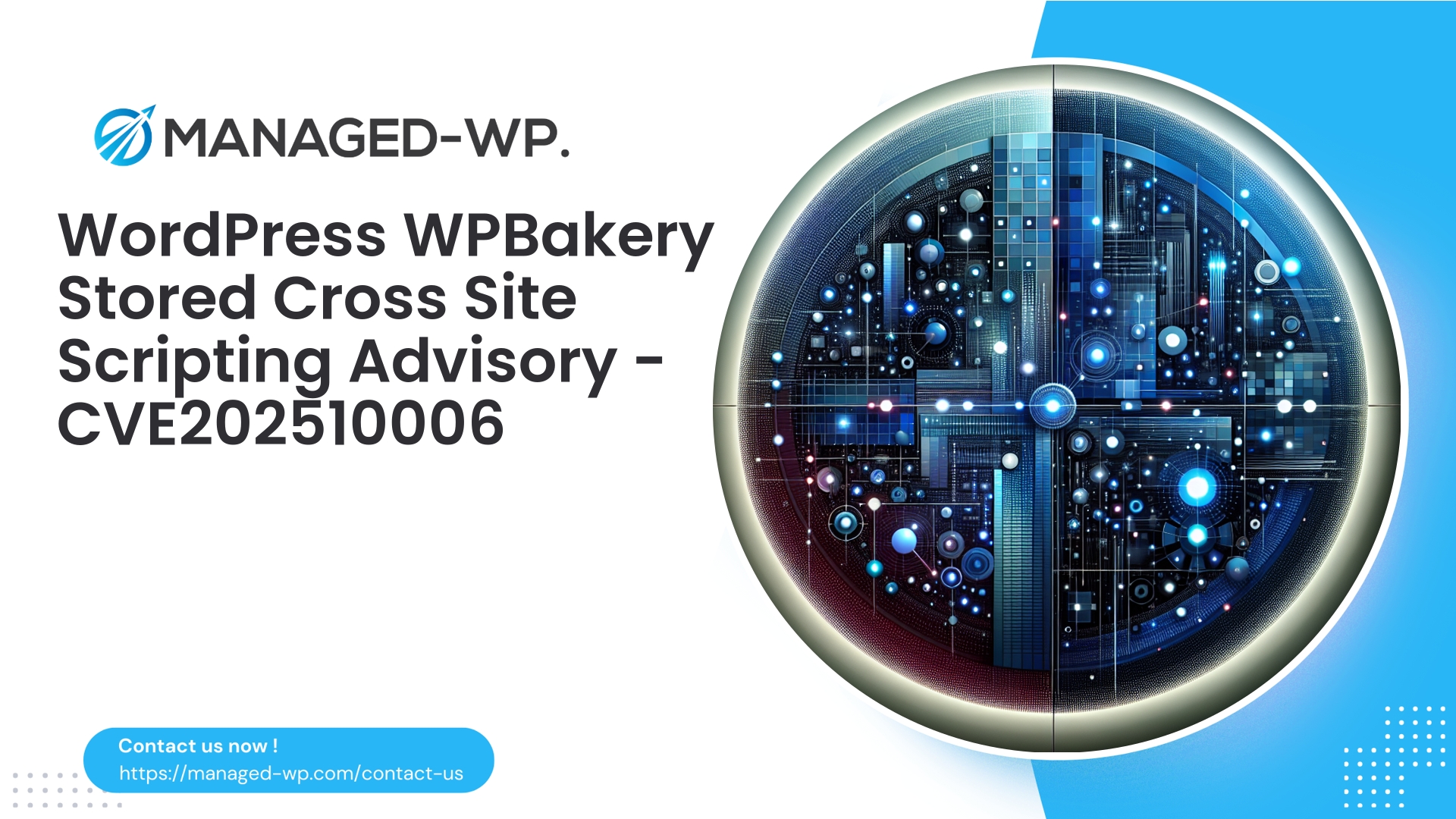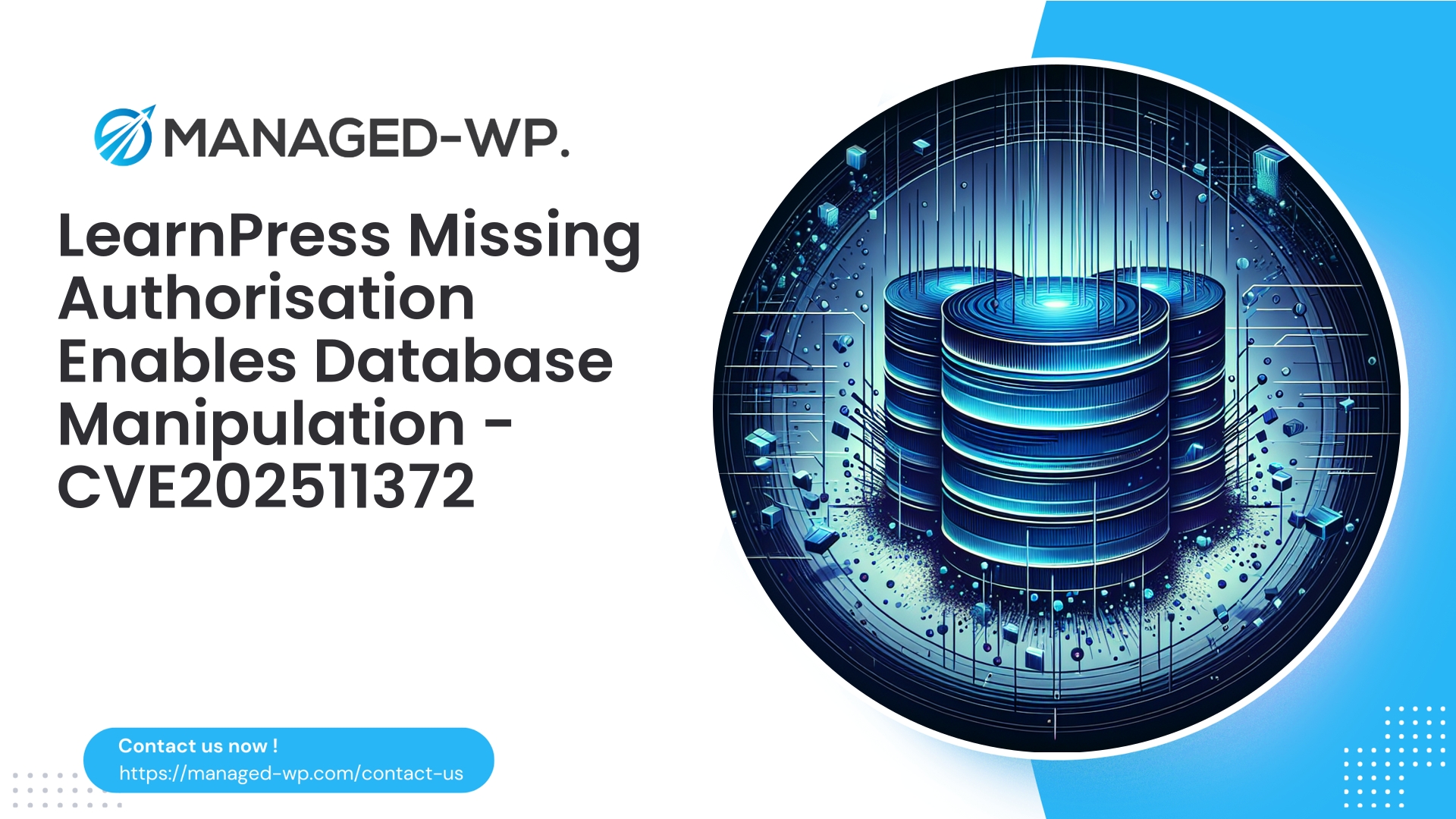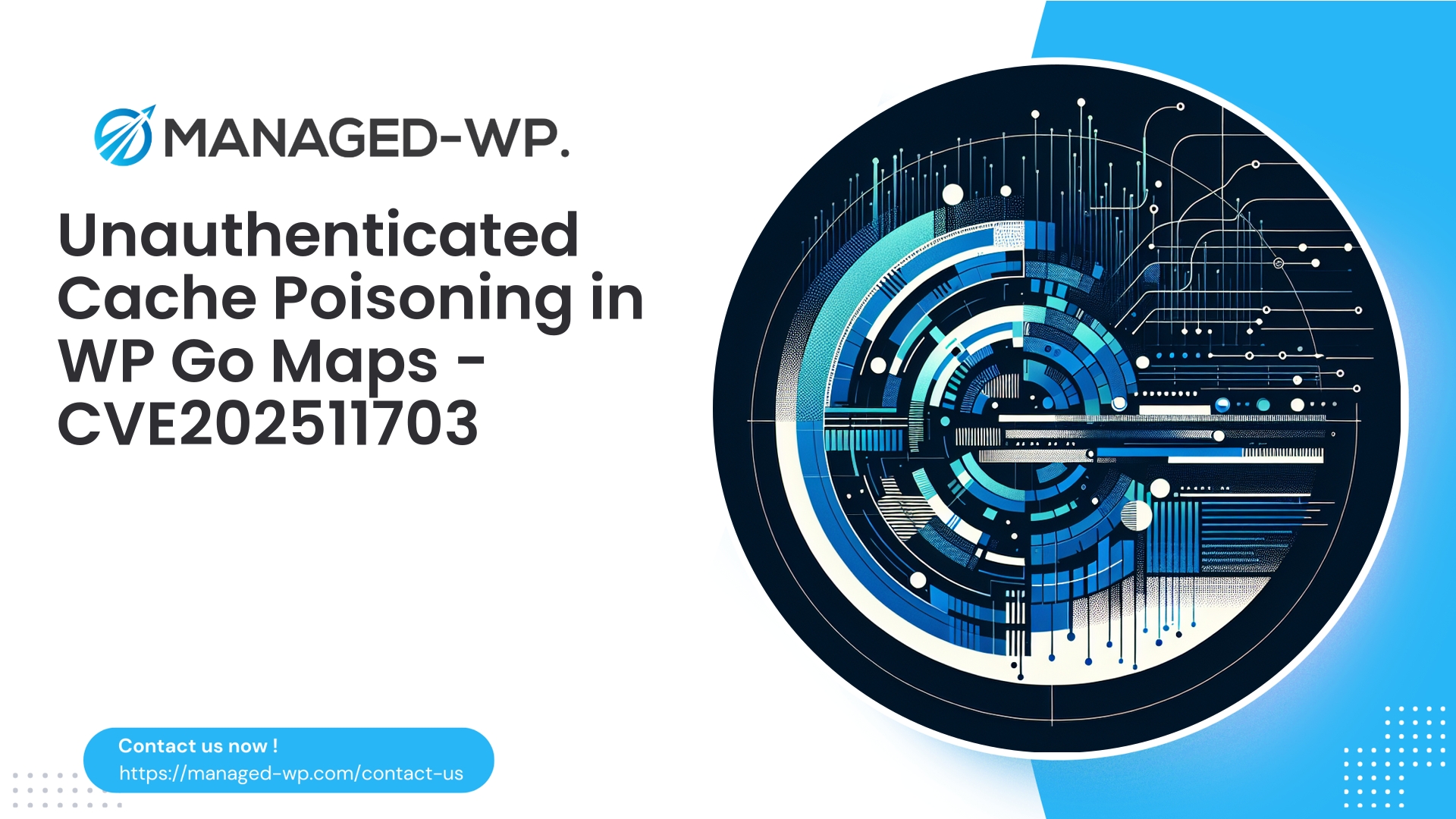| 插件名稱 | WPBakery 頁面建立器 |
|---|---|
| 漏洞類型 | 儲存型XSS |
| CVE編號 | CVE-2025-10006 |
| 緊急 | 低的 |
| CVE 發布日期 | 2025-10-18 |
| 來源網址 | CVE-2025-10006 |
WPBakery Page Builder <= 8.6 – 已認證儲存型 XSS 漏洞 (CVE-2025-10006):風險概述、偵測方法以及 Managed-WP 如何保護您的網站
這是一份權威且實用的 WordPress 網站所有者和管理員簡報,內容涵蓋影響 WPBakery Page Builder 8.6 及更早版本的已認證儲存型跨站腳本 (Stored Cross-Site Scripting) 漏洞。了解攻擊途徑、相關風險、緩解技術、事件回應指南,以及 Managed-WP 的安全層如何主動保護您的環境。
作者: 託管 WordPress 安全團隊
日期: 2025-10-18
標籤: WordPress、WPBakery、XSS、網路安全、WAF、事件回應
執行摘要
安全研究人員揭露了一個影響 WPBakery Page Builder 8.6 及更早版本的儲存型跨站腳本 (XSS) 漏洞,漏洞編號為 CVE-2025-10006。此漏洞允許擁有至少「貢獻者」權限的已認證使用者向頁面元素注入惡意 HTML 或 JavaScript 程式碼。這些惡意程式碼會被持久保存,並在頁面渲染時執行,無論是在前端還是在管理介面中。
儘管貢獻者的權限有限,但在頁面建立器環境中嵌入可執行腳本的能力顯著增加了安全風險。惡意攻擊者可以利用此漏洞劫持管理員會話、提升權限、植入後門或引入持續的 SEO 垃圾郵件。 WPBakery 已在 8.7 版本中修復了此漏洞。本文詳細介紹了威脅情勢、偵測方法、即時緩解策略,以及 Managed-WP 如何利用虛擬修補程式和 WAF 防護來有效阻止漏洞。
哪些人應該關注?
- WordPress 網站運行的是 WPBakery Page Builder 外掛程式版本 8.6 或更低版本。
- 安裝允許具有貢獻者角色(或更高角色)的使用者編輯或創建 WPBakery 驅動的內容。
- 缺少額外安全層(例如強大的 Web 應用程式防火牆 (WAF) 或嚴格的角色和功能配置)的網站。
如果您的網站已更新至 WPBakery 8.7 或更高版本,供應商提供的修補程式可以降低此風險。但是,如果由於相容性或測試方面的考慮而無法立即進行補丁更新,則必須採取如下所述的補償措施。
漏洞分析
關鍵訊息一覽:
- 漏洞類型:儲存型跨站腳本攻擊 (XSS)
- 所需權限:貢獻者角色(已認證使用者)
- CVE ID:CVE-2025-10006
- 受影響版本:WPBakery Page Builder ≤ 8.6
- 已在 WPBakery 8.7 修復
技術概要:
WPBakery Page Builder 依賴基於短程式碼的內容建構方式,讓使用者在頁面元素中插入 HTML 程式碼片段。此漏洞源自於貢獻者輸入的內容在持久化之前未經過適當的清理或轉義。以這種方式嵌入的惡意腳本標籤會在相關內容渲染時執行,無論是在預覽、管理介面或面向公眾的網站中。由於漏洞的持久性,因此必須採取措施進行緩解。
我們刻意避免在此分享漏洞程式碼;我們的重點是提高公眾意識並推廣有效的防禦策略。
為什麼至關重要
- 管理員帳號接管: 攻擊者可以透過在管理員預覽或編輯期間執行惡意腳本來竊取管理員會話 cookie 或執行未經授權的管理員操作。
- 長期網站受損: 儲存型 XSS 可能允許植入後門或自動建立特權帳戶。
- 搜尋引擎優化和品牌聲譽損害: 惡意內容注入、垃圾郵件或釣魚頁面會嚴重損害搜尋排名和訪客信任度。
- 資料竊取風險: 惡意腳本收集的訪客資訊可能會被竊取。
雖然一些評分系統將此漏洞的嚴重程度評為低到中等,但實際影響很大程度上取決於站點角色、管理員行為和現有的安全控制措施。
潛在攻擊場景
- 惡意貢獻者透過 WPBakery 注入腳本;管理員預覽內容時,在不知情的情況下執行了有效載荷,從而危及敏感會話。
- 嵌入在已發布頁面中的腳本會操縱前端訪問者,執行不必要的重定向、加密貨幣挖礦或註入聯盟垃圾郵件。
- 老練的攻擊者會部署僅在特定條件下啟動的條件載重,以逃避偵測。
檢測可能的漏洞利用
網站管理員應主動審核:
- 插件版本: 請透過 WordPress 控制面板或 WP-CLI 驗證 WPBakery 的版本。版本 ≤ 8.6 有漏洞。
- 投稿內容審核: 檢查具有「貢獻者」權限的使用者的近期內容,尋找可疑的腳本元素。
- 資料庫掃描: 在帖子和元資料中搜尋腳本有效載荷。初步查詢範例:
SELECT ID, post_title, post_author FROM wp_posts WHERE post_content LIKE '%
- 日誌檢查: 審核 WAF 和 Web 伺服器日誌,尋找包含已知 XSS 向量的請求或來自貢獻者的異常 POST 活動。
- 瀏覽器調試: 預覽可疑頁面時,請在控制台中尋找注入的腳本。
- 文件完整性檢查: 使用安全插件或外部掃描器尋找未經授權的檔案修改。
立即採取的補救措施
- 升級 WPBakery 插件
- 請立即更新至 8.7 或更高版本,這是徹底的解決方案。
- 暫時限制貢獻者權限
- 使用角色管理外掛程式或自訂函數停用貢獻者對 WPBakery 的編輯權限。
- 清理前端渲染
- 使用過濾器限制投稿者提交的帖子中不安全的 HTML 程式碼。
- 部署 Web 應用程式防火牆 (WAF)
- 實作或增強配置為阻止儲存型 XSS 攻擊向量的 WAF。 Managed-WP 提供針對此類威脅的虛擬補丁。
- 控制預覽環境
- 指示管理員在安全模式下預覽內容,以阻止 JavaScript 執行或限制貢獻者內容的渲染,直到修復為止。
- 加強會話安全性
- 確保會話 cookie 包含 HttpOnly、Secure 和 SameSite 屬性,以減輕基於腳本的 cookie 竊取。
- 輪換憑證
- 根據洩漏範圍考慮重設密碼和 API 金鑰。
Managed-WP 如何保護您的網站
Managed-WP 採用縱深防禦策略,結合持續監控、預防和快速反應層,專門針對 WordPress 威脅進行最佳化:
- 託管式 WAF 和虛擬補丁
- 一旦有新的漏洞披露,Managed-WP 會迅速制定並部署 WAF 規則,在應用程式邊緣攔截攻擊負載,阻止惡意 POST 資料和不安全的管理員預覽。
- 虛擬修補程式可在您規劃和測試官方外掛程式更新時提供即時保護。
- OWASP十大風險覆蓋範圍
- 我們的規則集透過阻止危險的內聯腳本和屬性,緩解各種注入攻擊,包括儲存型 XSS 攻擊。
- 主動惡意軟體和內容掃描
- 持續掃描可以及早發現 WP 資料庫和檔案系統中的可疑腳本或註入內容。
- 基於角色的存取控制強化
- 引導式使用者介面和建議透過限制貢獻者對 WPBakery 功能的權限來幫助減少攻擊面。
- 審計日誌和警報
- 全面追蹤內容變更,並對低權限使用者意外添加腳本的行為發出警報。
- 事件回應工具和支持
- 提供全面清理服務以及專家管理服務,以協助法醫調查和補救工作。
概念性防禦規則範例
為了說明 Managed-WP 的 WAF 規則如何應對這種威脅(不洩漏漏洞利用細節):
- 如果有效負載包含腳本標籤或可疑屬性,則攔截並封鎖傳送到管理端點的 XHR 或 POST 請求,例如
錯誤=結合 JavaScript 偽協定。 - 阻止渲染或預覽投稿者貼文中包含內聯腳本的回應。
- 對超出可信任白名單範圍的 HTML 內容提交者實施速率限制並要求進行驗證。
這些規則兼顧了安全性和可用性,最大限度地減少了誤報,同時有效地阻止了儲存型 XSS 攻擊嘗試。
事件回應手冊
如果您懷疑您的網站已被入侵,請按照以下步驟操作:
- 遏止威脅
- 暫時停用 WPBakery 或將您的網站置於維護模式。
- 撤銷 WPBakery 中貢獻者的編輯權限,直到問題解決為止。
- 封鎖可疑IP位址並監控帳戶活動是否有異常。
- 保存法醫證據
- 對文件和資料庫進行完整備份。
- 保護所有相關日誌——Web 伺服器日誌、WAF 日誌和存取日誌——以維護證據鏈。
- 確定攻擊範圍
- 搜尋貼文和元資料中的惡意腳本。
- 檢查上傳檔案、主題和外掛目錄是否有未經授權的變更。
- 檢查使用者帳號是否有未經授權的權限提升。
- 移除惡意載重
- 使用 Managed-WP 掃描和清理工具,從受影響的內容中移除未經授權的腳本標籤和有效載荷。
- 從可信任備份或官方來源替換或還原損壞的檔案。
- 重置憑證和密鑰
- 重設管理員密碼、API金鑰,並使所有活動會話失效。
- 應用補丁
- 將 WPBakery 和所有其他外掛程式/主題更新到最新穩定版本。
- 恢復和監控
- 網站上線後,監控是否有反覆出現的惡意活動。
- 修復後至少 30 天內,應保持 WAF 保護措施,特別是虛擬修補程式。
- 事故後強化
- 記錄根本原因和補救措施。
- 貫徹最小權限原則,啟用雙重認證,並安排定期安全性稽核。
加固建議
- 盡快將 WPBakery Page Builder 升級到 8.7 或更高版本。
- 如果無法立即升級:
- 限制貢獻者對 WPBakery 的存取權限。
- 對使用者產生的內容應用嚴格的過濾機制。
- 使用具有虛擬修補功能的 WAF 來防止 XSS 攻擊。
- 強制使用強管理員密碼並啟用多因素身份驗證 (MFA)。
- 僅使用信譽良好且積極維護的插件。
- 定期監控日誌並啟用檔案完整性檢查。
- 安排每週自動掃描和每月人工審核低權限使用者內容。
- 使用內容安全性原則 (CSP) 來限制內聯腳本,從而減少攻擊面。
- 設定 cookie 時使用 HttpOnly、Secure 和 SameSite 屬性。
安全修復注入腳本
- 備份資料後,仔細執行資料庫查詢,以識別可疑貼文。
- 尋找腳本指示符,例如
<script,錯誤=,javascript:以及相關模式。 - 謹慎移除惡意標籤和屬性;在生產環境部署之前,請考慮在測試環境中執行自動化腳本。
- 清理後,使用惡意軟體掃描程式重新檢查網站並查看 WAF 日誌。
預防復發
- 修改編輯流程,讓投稿者提交內容進行審核,而不是直接發布。
- 對內容團隊進行培訓,讓他們了解嵌入未經審核的 HTML 或 JavaScript 程式碼的風險。
- 僅允許核心管理員安裝和管理外掛程式。
- 維護測試環境,並確保在生產環境上線前及時更新插件。
虛擬修補的重要性
雖然升級是最終的解決方案,但諸如主題依賴項或計劃維護窗口等生產環境因素可能會延遲補丁的發布。 Managed-WP 的虛擬修補程式功能使用針對性的 WAF 規則即時攔截攻擊嘗試,從而在官方更新之前顯著降低風險。其優點包括:
- 測試和升級計劃階段的保護措施。
- 阻止大規模自動化攻擊掃描易受攻擊的網站。
- 影響小且可逆的安全控制措施,避免造成插件移除的破壞性影響。
Managed-WP 的虛擬修補程式專門針對此類儲存型 XSS 攻擊所使用的儲存輸入模式,並保護在攻擊期間被針對的管理預覽端點。
立即使用 Managed-WP 保護您的 WordPress 網站
立即開始使用 Managed-WP 的免費保護計劃
Managed-WP 的免費方案提供即時、便利且配置極少的託管式安全保護,包含以下基本安全功能:託管式防火牆(含 WAF)、無限頻寬、持續惡意軟體掃描以及針對 OWASP Top 10 漏洞的防護。如果您無法立即修復存在漏洞的插件,這無疑是降低風險的絕佳第一步。了解更多或在此註冊:
https://my.wp-firewall.com/buy/wp-firewall-free-plan/
考慮升級到高級套餐,以獲得更高級的惡意軟體清除、IP 控制和專家管理服務。
實用命令和查詢(謹慎使用)
- 透過 WP-CLI 列出已啟用的外掛程式及其版本:
wp plugin list --status=active
- 執行查詢前,請使用 WP-CLI 和 mysqldump 備份資料庫。
- 尋找包含腳本標籤的貼文:
SELECT ID, post_title, post_author, post_date FROM wp_posts WHERE post_content LIKE '%- 盡可能始終在備份或只讀資料庫副本上執行操作。
- 找出上傳目錄和主題目錄中最近修改過的檔案:
- 使用完整性掃描器或
尋找基於修改時間戳記的命令。
- 使用完整性掃描器或
常見問題解答
- 問: 清理後,惡意腳本是否還會因為快取/CDN 而殘留?
一個: 是的,殘留的快取內容可能會繼續傳播惡意負載。清理後,請務必徹底清除所有快取和 CDN 邊緣節點。 - 問: 其他頁面建立器外掛程式是否也存在同樣的問題?
一個: 每個插件的安全狀況各不相同。請務必遵循供應商的建議,並相應地套用虛擬修補程式和更新。 - 問: 僅靠內容安全策略 (CSP) 就足夠了嗎?
一個: CSP 可以與其他防禦措施相輔相成,但並非獨立存在。要實現有效的保護,必須將 CSP 與資料清理、角色強化和 Web 應用防火牆 (WAF) 等措施結合,並進行正確的部署。
推薦安全路線圖
- 清點您的 WPBakery 外掛程式版本和角色。
- 盡可能立即將 WPBakery 更新到 8.7 或更高版本。
- 配置 Managed-WP 虛擬補丁,並在補丁延遲時限制貢獻者權限。
- 審核並清理資料庫和文件,檢查是否有註入腳本。
- 實施最小權限原則、多因素身份驗證,並定期輪換憑證。
- 持續監控並更新工作流程,以確保內容管理的安全。
最後的想法
雖然儲存型 XSS 漏洞 CVE-2025-10006 看似只需要貢獻者等級的存取權限,但如果不加以解決,其影響可能會蔓延至整個網站。實現安全環境的最快方法是將 WPBakery 升級到 8.7 或更高版本。如果無法立即升級,則必須採用分層防禦策略,包括角色強化、全面掃描、HTTP 安全標頭以及 Managed-WP 的託管 WAF(具有虛擬修補程式功能),以保護管理員和前端使用者的安全。
如需託管式、無需人工幹預的安全防護,以減少風險並即時阻止攻擊嘗試,請立即試用 Managed-WP 的免費方案:
https://my.wp-firewall.com/buy/wp-firewall-free-plan/
需要個人化幫助? Managed-WP 可以:
- 根據您使用 WPBakery 的情況,提供一份客製化的安全檢查清單。
- 在您的網站上執行自動掃描或套用虛擬補丁。
- 幫助您安全地回滾更改並部署補丁,而不會破壞您的設計。
請聯絡 Managed-WP 安全團隊,以便優先處理針對您環境量身訂製的修復方案。



















